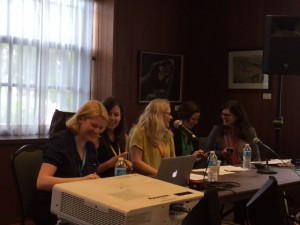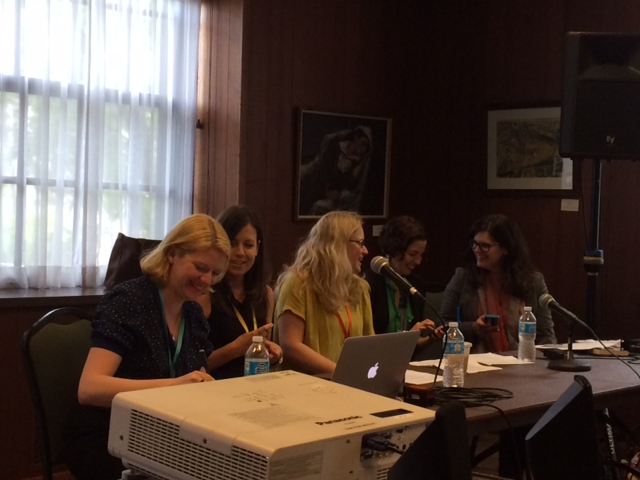
I recently got back from one of my favorite conferences of the year – Games, Learning & Society in Madison, Wisconsin. This amazing gathering, which brings together academics, designers, teachers, distributors, and many other bright lights of the learning games community, was celebrating its 10th anniversary this year, and feels more relevant than ever.
As more and more people are exploring the power of games and how they can impact learning in a wide range of areas, this year’s conference presented a terrific opportunity to take a break from the noise for a second and gain insights from some of the folks who’ve been at this for the last decade (and much longer than that, in some cases). Their presentations, panels, and sessions offered perspectives from professors, game designers, developers, publishers, research and innovation groups, classroom teachers, and many others who have a stake in the present and future of learning games. Here are some of the most resonant takeaways.
Beware the Creepy Treehouse

Drew Davidson, the Director of the Entertainment Technology Center at Carnegie Mellon University and the Founding Editor of ETC Press, gave an inspiring and often hilarious look at the current state of learning games in his keynote address. He talked about many things, including why he requires all incoming students to take improvisational theater classes alongside programming and design (it encourages teamwork and openness to the ideas of others). But one of his most salient points for developers of learning games was his warning about “the creepy treehouse” — a phrase that I hadn’t heard before but was instantly resonant.
The creepy treehouse is, essentially, a space that adults have built that pretends like it’s for kids. The term is often used to refer to social media or other affinity spaces being co-opted as learning environments for students — say, having students friend teachers on Facebook or follow them on Twitter — but can more broadly refer to adults “hiding” themselves in things that at first glance look like unstructured kid-centered fun. Needless to say, kids recognize this immediately, hence the creepiness, and they don’t want to play there.
Being wary of creating creepy treehouses is an important goal for learning games developers, who sometimes mistake throwing game-y mechanics on top of dry curriculum for a fully integrated learning experience. It’s basically chocolate covered broccoli taken to the next level, and something we all need to police ourselves against.
Co-Dependence Can Be a Good Thing

I was fortunate to organize a panel called “Anatomy of a Learning Game: From Design to Development to Distribution,” with some of my rockstar colleagues and collaborators, including an assessment expert, a creative director, a games curator, and a public school teacher, all of whom have in one way or another contributed to Classroom Inc’s new learning game, After the Storm. (You can read more about the panel in this terrific post from panelist Leigh Hallisey, Creative Director for FableVision, an awesome learning games developer and our partner on After the Storm.)
The panel helped to remind me just how much goes into making and distributing a successful learning game, and highlighted how much we all rely on each other. None of us work for Disney, or Scholastic, or Pearson. We’re all at small-to-medium sized companies who can only afford to have so many in house experts on staff, and so pairing up and working together is an inevitable — and often quite delightful — part of the process.
These partnerships are also critical to making learning games a valid option for schools, parents, and others who care about real quality, rigorous research, and definable results. If we as a community believe in games as real vehicles for learning, we don’t have the luxury of ignoring each other. We must support each other, inform each other, and teach each other. If we’re going to have learning games taken seriously beyond the App Store, people who care about learning games have to recognize we are an affinity group of our own, and our ultimate success depends on a rising tide lifting all high-quality boats.
Digital Games Are Already in the Classroom in a Big Way
The Joan Ganz Cooney Center released a preview of their forthcoming report on the use of digital games in the classroom and it contains a TON of excellent intel for anyone who’s interested in making games for schools (or really, anyone who wants to get a snapshot of critical trends in the education system and its relationship to technology).
An amazing 78% of teachers report currently using games in the classroom, with a majority of those using them at least once a week. As of right now, 72% of those are using desktop or laptop computers, though tablets are gaining ground as well. I encourage you to read the highlights yourself, but the report suggests the opportunities around learning games for schools are huge. It also, however, takes a clear-eyed picture of the challenges teachers face implementing them, and for those who want to develop for these environments, having a firm sense those obstacles is key.
Remember the Three “E”s

Jessica Lindl of GlassLab, the organization behind SimCityEDU, wrapped the up the keynote talks with her presentation, “Join in the Ultimate Game: Closing the Engagement Gap in Education.” The speech was an excellent and cohesive look at what games need to do to be taken seriously in schools, and Lindl spoke persuasively about the three “E”s that learning games need to provide to teachers and administrators: Engagement, Ease of Use, and Efficacy.
Engagement is probably the first argument many of us can think of in favor of using games in schools. There’s no question that drawing kids in is one of the most obvious reasons to use games in schools (and the Cooney Center Report bears this out, as teachers cite low-performing students, those who may be disengaged, as seeing the greatest benefit from learning games). There is plenty of research showing that games can be an engaging way of presenting curriculum, so this one is fairly straightforward.
Ease of use is just as critical, however, and often a lot more challenging for developers to provide. Classrooms that frequently lack consistent broadband connections or space on their tablets for large applications (remember Carla’s post on file size?). In an ideal situation, a teacher might have a laptop cart in their classroom with one laptop per student, or a tablet for every desk. But, it’s also possible they might have limited computer access in a lab once or twice a week, or that students might have to share machines. Even in the best tech setups, sometimes applications fail to run properly, and if a teacher has a class full of students waiting for a lesson, they’re unlikely to have the time to troubleshoot a buggy or unresponsive program. A teacher that I spoke to this week says she has a “three strike” rule with games for her class — if she can’t get it to run three times when she needs it, no matter how good the game, she just isn’t going to bother anymore. Teachers truly don’t have the time to waste to figure out how to make your game work for them.
Finally, efficacy needs to be shown, whether it’s through assessments or other data that prove to those making the schedules that games are a valuable use of teacher’s already thin-stretched time. Assessments and data were all the buzz at GLS this year as they have been at many others, and we all have heard plenty about big data and its potential in education. But the bottom line is teachers and administrators don’t need to be barraged with unsorted piles of student data and statistics. What they need is actionable information that can help them with what is most important to them — helping their students grow and learn.
So that’s a quick rundown of the things that have stuck with me the most, one week post-GLS. Want to dig deeper into the wild world of learning games? I suggest making sure you book a trip to Madison next year for GLS11. In the meantime, you can always email us at KidsGotGame@NoCrusts.com, follow us @NoCrusts on Twitter, or sign-up to receive email updates from us.






















